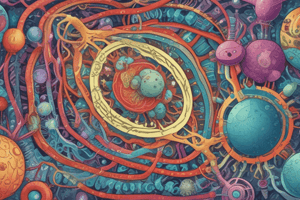Podcast
Questions and Answers
What is the primary function of the capsid in a virus?
What is the primary function of the capsid in a virus?
- To transcribe the viral genome into mRNA
- To protect the viral genome from external harmful factors (correct)
- To translate the viral genome into protein
- To replicate the viral genome
What type of symmetry is characterized by a helical arrangement of capsomeres?
What type of symmetry is characterized by a helical arrangement of capsomeres?
- Icosahedral symmetry
- Complex symmetry
- Cubical symmetry
- Helical symmetry (correct)
What is the term for a nucleic acid that encodes the information for making viral protein?
What is the term for a nucleic acid that encodes the information for making viral protein?
- Single-stranded nucleic acid
- Negative sense nucleic acid
- Positive sense nucleic acid (correct)
- Double-stranded nucleic acid
What is the primary component of the viral envelope?
What is the primary component of the viral envelope?
Which of the following viruses has a naked nucleic acid that is infectious?
Which of the following viruses has a naked nucleic acid that is infectious?
What is the term for the protein structures that project from the viral envelope as spikes?
What is the term for the protein structures that project from the viral envelope as spikes?
Flashcards are hidden until you start studying
Study Notes
Morphology of Viruses
- A virus consists of nucleic acids and proteins.
- The viral genome contains genetic information for multiplication and is surrounded by a protein coat called the capsid.
- The capsid is made up of polypeptides called capsomeres.
- The genome and capsid are collectively called the nucleocapsid.
Structure of Viral Genome
- The nucleic acid can be RNA or DNA, double-stranded or single-stranded, linear or circular, and plus or minus polarity.
- The nucleic acid can be segmented or unsegmented.
- Positive sense nucleic acid encodes the information for making viral protein.
- Negative sense nucleic acid is made up of complementary base to those of a positive sense nucleic acid.
Function of Capsid
- The capsid protects the viral genome from external harmful factors.
- It introduces the viral genome into the host cells.
- The capsid is antigenic and specific for each virus.
Symmetry of Viruses
- Three types of symmetry exist for viruses: icosahedral or cubical symmetry, helical symmetry, and complex symmetry.
- The arrangement of capsomeres around the nucleic acid determines the symmetry.
Enveloped and Non-Enveloped Viruses
- Viruses can be either enveloped or non-enveloped.
- The envelope surrounds the nucleocapsid and is made of lipoprotein.
- The lipid part is from the host cell membrane, and the protein part is virus-coded.
Characteristics of Envelope Viruses
- Envelope viruses are susceptible to heat and lipid solvents like ether.
- The envelope is made up of peplomers, which are antigenic and can bind to surface receptors facilitating entry.
Viral Proteins
- There are two types of viral proteins: structural and non-structural proteins.
- Structural proteins are present in the coat of the viruses.
- Non-structural proteins are viral enzymes and haemagglutins.
Types of Viral Enzymes
- Four groups of enzymes have been detected in viruses:
- Neuraminidase or sialidase
- RNA polymerase (copies DNA into RNA)
- Reverse transcriptase (RNA-dependent DNA polymerase transcribes RNA into DNA)
- Enzymes of cellular origin
Classification of Viruses
- Various methods exist for classification of viruses, including Holmes Classification, which is based on host.
Studying That Suits You
Use AI to generate personalized quizzes and flashcards to suit your learning preferences.




